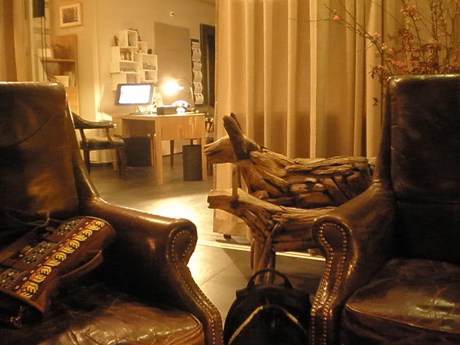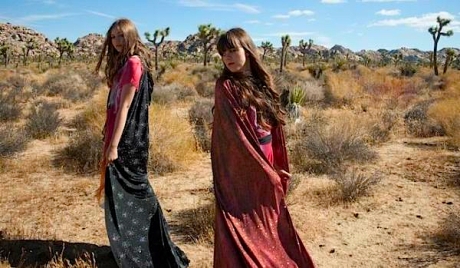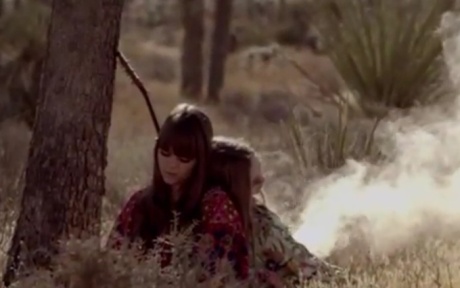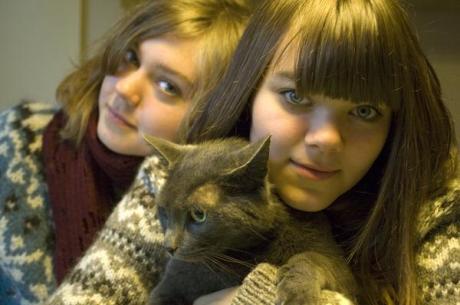Low-fi, mellowtone sounds: First Aid Kit on the heroes of bygone days and why sibling harmonies are so special
Nachdem Klangverführer @ fairaudio schon längst wieder aktiv ist, wird es Zeit, auch den Klangblog selbst aus dem Neujahrsschlaf zu wecken. Und was könnte dazu besser geeignet sein als ein Interview mit den als kommende Folk-Sensation gefeierten Schwestern Johanna und Klara Söderberg, die aktuell als First Aid Kit mit ihrer zweiten CD The Lion’s Roar aufhorchen lassen – natürlich auch Victoriah’s Music, wo die Album-Rezension vorige Woche erschienen ist.
Die charmanten Schwedinnen traf ich diesen Montag im nicht minder charmanten Berliner Hotel The Circus zum Klangverführer-Interview.
Klangverführer: When I listen to your records and look at your pictures,
I cannot help a feeling of nostalgia. Would you have rather lived in the old times?
Johanna: No. I mean, it’s hard to say because we haven’t been there so we don’t know how it was, and I think we’re probably romanticizing and idealizing a lot of it, you know, it wasn’t all happy days – but the music they created back in the days was amazing. I think we try to do something like this with our music, but when it comes to living I think it’s better now. That doesn’t automatically make the music better, unfortunately.
Klara: Yes and I think we like the fact that the kind of music that we make, folk and country inspired music, could be popular. In the Sixties, artists like Joni Mitchell could top the charts, and that’s the thing we really like and wish we could sort of be … it could be the same today. In that sort of way we could look back, indeed, I think.
Well, I in fact do experience that folk music is popular again, these days. Currently so many young musicians seem to make a kind of music that sounds like the soundtrack of their parents‘ youth! What do you think makes this kind of music so suitable for our times?
I think it’s a matter of timelessness. It is always relevant! Today, it might be a reaction towards the trends of electronic music, and I think it’s the pure voices and the most simple, pure forms that affect people. You know, that’s what Folk music does: the vocals, the harmonies are so beautiful, so well done, and people always long for a human voice! Being confronted with so much technology, people tend to look back at the earlier times and think they were easier – or maybe even more real.
Your current single is called Emmylou, which refers to Country & Folk singer Emmylou Harris. In the same song you also mention heroes like Johnny Cash or June Carter. How would you explain your personal fascination with the popular music of bygone days?
Well, Gram Parsons and Emmylou Harris, June Carter and Johnny Cash are very special because they harmonize together and they were couples – kind of. Well, Johnny Cash and June Carter were married and Gram and Emmylou weren’t, but … Wen you listen to their music it’s hard not to imagine that they were more but just friends. You can sort of hear … love. And we just think that they all were fantastic songwriters and musicians, and the song is about wanting to share that kind of connection with somebody and sing with them, because we believe that singing with someone is such a special thing and it’s so intimate! The song is to say that even if we can’t be together like Emmylou and Gram, we can sing together.
Kind of an homage to duet singing?
Yeah, kind of!
But it’s also an homage to your heroes, isn’t it? You even shot the video of Emmylou on the birthday of your idol Gram Parsons …
Johanna: Yes, we shot it in Joshua Tree, which is Gram Parsons’ favorite place. But the date was chance … or destiny, maybe. (laughs)
Klara: We had planned to make the video and then we realized when we got there, oh, it’s Gram’s birthday, that was pretty special.
Your first EP Drunken Trees contained a cover of the Tiger Mountain Peasant Song by the Fleet Foxes, who by critics are compared to the psychedelic bands of the Sixties and Seventies, like The Byrds …How came you decided to do a Fleet Foxes cover?
Johanna: Well, we saw them live in Gothenburg in Sweden at a festival called “Way out West” and it was a very … almost like a religious experience. They were at the beginning of their career and they were so overwhelmed by the positive response they got from the audience, and the show was just incredible, we loved their first record, it was our favorite, we listened to it all the time that summer! And so we just wanted to give them something back for that experience we had at the show; and so we went out in the forest with my digital camera … we never thought at any moment that anyone would actually watch it!
But actually, your version of the Tiger Mountain Peasant Song became highly popular on YouTube in 2008. Would you say that social media became a kind of catalyst for your musical career?
Oh yeah, definitely! I mean, the video brought us an international audience. It’s pretty crazy because it’s something we did for fun!
When your debut album The Big Black & the Blue appeared in 2010, your MySpace tagline stated that you “aim for the hearts, not the charts”. Will this approach remain valid with the release of your first American-recorded album?
Of course we also care for the charts, because we try to make a living out of our music, but music is so important to us that we’ll continue making music regardless if somebody listens or not, that’s not the point in it. For us, music is like a therapy – we listen to music to get through hard times and we create music also to get through hard times, so if other people … if we can reach someone’s heart with our music, that’s kind of the reason why we do this! So I think the claim is still true.
Your current album, The Lion’s Roar, is the first one you have worked on with a producer. How did Mike Mogis affect the sound of your music or your musical approach in general?
Well, I think without Mike Mogis our music wouldn’t sound like it does in the first place because he produced the Bright Eyes records that influenced us so much. So it goes way back – he’s part of our first record even though he didn’t produce it! But we worked a lot on making the arrangements a little bigger and he really got what we were trying to say with our lyrics, the kind of emotion we aimed at. He just sort of made them more apparent or dramatic, maybe, which is something that we wanted to do. The sound we aimed for but not overpowering it. The focus is on the harmony and the lyrics to get the message through. When we did our first album, we were kind of limited because we recorded it at home. We didn’t actually even have the space for a string quartet or the like. Now that these limitations disappeared, we could make clearer on this record what kind of music we like and what has influenced us.
Haven’t you been afraid that your music would lose its home-made charm due to the bigger production?
Not really, because for us it was never important that we had a certain homemade charm or a low-fi appeal. Our current sound is something we aimed for. We just wanna make honest music, and we were aiming for having a better sound. I think that there’s a charm to the first record because it sounds home-made, but at the same time you don’t really get how our voices sound. A lot of people who saw us live said to us, “oh, this is how you sound” and they preferred our live shows because they were actually better than our CD. And therefore it’s really great having worked with Mike because he’s such a master of making vocals sound great and stand out. Besides, I don’t think our new album is polished because we used a lot of low-fi, mellowtone sounds, it’s not like the standard production, it’s not perfect! And our vocals are pretty much untouched, we didn’t use Autotune or anything like that. It’s more or less us singing in a room and then more and more instruments in. We used different equipment, but it’s still very much just us singing about our personal experiences and feelings.
And how did this collaboration with Mike Mogis come into being?
Well, Monster of Folk (that is Conor Oberst, Jim James, M. Ward and Mike Mogis, author’s note) played in Stockholm, and we had our first album out by that time. So we went there and gave it to them. You know, they were our idols, and one year later they showed up at a show we had in Austin, Texas, and told us that they loved the album. And after the show we heard Mike Mogis saying that he wanted to produce our new album, so a few months later we were in Omaha recording.
Sounds like a fairytale …
Yeah, it is!
Your EP Drunken Trees as well as your album debut The Big Black & the Blue was produced by your father, who is a well-known musician in Sweden (e.g., he played with the rock band “Lolita Pop”). Has it always been clear to you that you wanted to be in your father’s business, too?
We always dreamed of being singers. But we always thought that it would be just a dream. I don’t think we ever really thought about it that our das has been in a band. He wasn’t playing anymore, it wasn’t like a big deal or anything. I think, unconsciously we were aware of it and thought that this is something that we could do, too – it was a possibility. We didn’t feel like this was so far away, so that’s how it influenced us.
So you didn’t get any musical education within your family and haven’t been pushed into music …
Johanna: Our parents were always very supportive, but they were never pushy. They gave us musical education in the form of good music playing all the time. And our dad taught Klara her first chords on the guitar …
Klara: Yeah, but this really came from us. With the guitar, it was, that I said I wanna learn to play the guitar, it really came out of nowhere when I started listening to Bright Eyes and Folk music, but my parents never thought that I would have wanted to play any instrument until I suddenly came up saying, “I wanna learn guitar”. So I asked my dad, can you show me some chords, I wanna play this song, and how to play a C-chord, so he was definitely important, but it was always … from us.
Then how came you recognized that you harmonize so well?
Johanna: The first time we sang harmonies was on a song Klara has written called “Tangerine”, and I started singing on the demo. But I think it took a while, until maybe a year later that people started talking about our voices and we realized that sibling harmonies are something special. We gradually had become better and better and now we kind of realize it’s so special because singing with your sibling is just like singing with yourself! Especially if you compare it to singing with someone else you’re not related to. We collaborated with other artists and had to adapt to their kind of voices, it’s a totally different deal! We have so much for granted if we sing together, like naturally, it just works. It’s really easy; we never have to think about it.
Are there any moments on your record when you can’t tell who is who?
Klara: Yeah, we heard people saying that! And I think especially when we listen back to us talking we really can’t tell. Sometimes it’s like: “Is that me or is that you?”, and that’s really spooky!
Johanna: And on this album we change voices, so I sing lead sometimes …
Klara: … and that confuses people! Of course, I am aware of what I’m singing, but for other people who don’t really know … I think they wouldn’t notice. Which is kind of fun – I like that when they don’t really know who is singing what. Like the Louvin Brothers in the Sixties, they sang close harmony and changed all the time – and I can’t tell who is Charles and who is Ira. I think it’s awesome! And we’d love to do that more, too.
Sounds like big fun! Well, I have one last question. During my research for the interview I came across an older photograph that pictures the two of you with a cat. Since my dog is an essential element of my music writing, I wondered about the story behind the picture.
Oh, this is our cat, Nisse. That’s the most common cat name in Sweden, it’s really boring, it’s like a version of Niels for Santa Claus‘ Tomte, Santa’s little helper … Look at his ears in this picture: He’s not really happy, he’s annoyed. He’s a very fat cat and he wakes us up every morning at five and wants us to feed him, but he’s adorable! I always forget about it when we are touring, it’s not really like “oh, I miss my cat”, but when I come home and see him I’m always so excited and you can see that he is excited that we are home, too. He sits in the window like … He’s the best!





